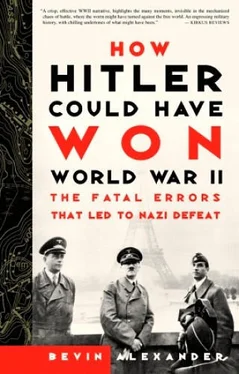The engineers were supposed to clear sixteen 50-yard-wide paths through the obstacles. But half the engineers were dead or wounded, and they managed to clear just one path in the first half hour. The landing craft bringing in the succeeding waves of troops crowded into this single corridor. As the ramps dropped, the men faced almost certain death or wounding. All along the beach landing craft sank or exploded as they hit mines or were struck by artillery.
Ashore, dead and wounded were scattered across the sand and shallows. The survivors lay in the sand or shallow water or crouched behind landing craft, hearing bullets clanging against the steel hulls. Howitzer shells blasted the beach and sent shrapnel flying. The DDs were knocked out, and the Americans had nothing to stop the murderous fire.
Four miles to the west, 225 men of the 2nd Ranger Battalion began scaling the cliffs of Pointe du Hoc to destroy the guns reported there. The Rangers shot rope ladders and rope-bearing grapnels onto the clifftop and started climbing, in the face of withering fire from above. A number of Rangers died, others blasted shelters and hand-holds in the cliff with their grenades. Meanwhile an American and a British destroyer moved in close and drove the enemy away from the top of the cliff with heavy fire. The Rangers hauled themselves up and discovered that the guns were not there. They had been moved back to an orchard. There the Rangers destroyed them.
DD tanks now began to come ashore. The novelist Ernest Hemingway, observing from a landing craft, saw two tanks start burning: “The first, second, third, fourth, and fifth waves [of infantry] lay where they had fallen, looking like so many heavily laden bundles on the flat, pebbly stretch between the sea and the first cover.” Hemingway also witnessed the Germans hitting another tank: “I saw two men dive out of the turret and land on their hands and knees on the stones of the beach,” he reported. “But no more men came out as the tank started to blaze up and burn furiously.”
The only thing that saved the infantry on Omaha was the U.S. Navy. Twelve destroyers moved in close to the beach, ignoring shallow water and mines, and turned every possible gun onto the German positions on the bluffs. This intense fire diminished German resistance, and permitted the soldiers to slowly gain headway.
For six hours, Omaha was bloody chaos. The Americans held only a few yards of beach; the waves actually ran red with blood. Not until the principal commanders got ashore did the men begin to move toward the seawall and bluffs. Brigadier General Norman D. Cota, assistant commander of the 29th Division, strode calmly among the crouching soldiers. He yelled: “Two kinds of people are staying on this beach, the dead and those who are going to die. Now let’s get the hell out of here.”
Slowly, lone and mostly anonymous individuals of incredible heroism began to get things moving, creating breaches to open the draws to advance. In front of one such place, a lieutenant and a sergeant in the 16th Regiment took their lives in their hands and went up and found only barbed wire barred the way. The lieutenant returned to the GIs cringing behind a low shingle shelf on the beach. Standing with his hands on his hips, he said: “Are you going to lie there and get killed, or get up and do something about it?” Nobody moved, so the sergeant and the lieutenant blew the wire themselves. That gave the men courage enough to file through the gap and through a minefield.
There were many such events on June 6, 1944. By the end of the day the Americans had pushed out a patchwork of pockets over an area six miles long and two miles deep. Behind them, 3,000 Americans lay dead on Omaha beach.
Early on June 6, German duty officers in Normandy began to get frantic calls that thousands of paratroops were landing. The officers raced to field telephones to report to higher quarters, and the whole machinery of command went into action.
Erwin Rommel was in Germany for his wife’s birthday, assuming the bad weather would prevent an invasion any time soon, and his chief of staff, Hans Speidel, only reached him by phone at midmorning. Rommel at once started driving toward Normandy.
There was one panzer division within immediate striking distance of the beaches, the 21st, south of Caen. Two other divisions were fairly close: the Panzer Lehr in the vicinity of Chartres, and the SS Panzer Hitler Jugend just west of Paris. If they had moved at the first word of the invasion, they almost certainly could have smashed it, since the morning of June 6 was heavily overcast, and Allied fighter-bombers could not fly. But while Army Group B had control of the 21st Division, Hitler controlled the other two. Jodl refused to wake the Fuehrer, and questioned whether the Normandy landings were the main effort. It was 4 P.M. before the divisions were at last released.
The 21st Panzer had 150 tanks, 60 assault guns, and 300 armored troop carriers. Its commander, Edgar Feuchtinger, formed up part of his division to attack the British paratroops east of the Orne River in the morning, but got countermanding orders from 7th Army to attack west of the river. This caused delay and only a single battle group of fifty tanks and a battalion of panzergrenadiers launched the strike toward Sword beach about midday.
Around 9:30 A.M. the 1st Battalion of the British South Lancashires reached a point almost within sight of Caen when they encountered three antitank guns emplaced on a ridge. The South Lancs dug in and waited for the 65 tanks of the 185th Brigade, which were supposed to lead the midmorning attack toward Caen. For three hours the South Lancs sat there, while the tanks waited for the traffic jam on the Sword beach to clear.
Around 2 P.M. twenty Sherman tanks finally attacked the three AT guns, which withdrew, and the tanks’ accompanying force, the Shropshire Light Infantry, pressed on toward Caen. Just short of the town it ran into dug-in infantry, and withdrew to Biéville, four miles north. This was the closest the Allies got to Caen for a month.
Meanwhile the 21st Panzer battle group skirted around west of the Shropshires and drove northward with the intention of splitting Juno from Sword, and destroying each beachhead in turn. The Germans reached the unguarded coast between the two beaches at 8 P.M.
Feuchtinger was sending another fifty tanks to reinforce this advance when overhead the panzers saw the largest glider-borne force in the war, 250 transports, coming to reinforce the 6th Airborne a few miles east. Feuchtinger assumed wrongly that the gliders were landing in his rear with the intention of cutting off the division, and he recalled all his tanks. This fortuitous appearance of the gliders ended the last chance the Germans had to smash the beachheads.
The Germans made another fundamental error: they sent the two closest panzer divisions in daylight toward the Normandy beaches. Rommel and Guderian had preached against this, saying that troops had to move at night. But OKW ordered 12th SS Panzer Hitler Jugend Division, west of Paris, to advance on Caen on the late afternoon of June 6. It did not complete its 75-mile journey until 9:30 A.M., June 7. Friedrich Dollmann, 7th Army commander, ordered Panzer Lehr Division, near Chartres, 110 miles from the front, to drive in daylight on June 7 toward Villers-Bocage, fifteen miles southwest of Caen, to block British movement in that direction. Fritz Bayerlein, Panzer Lehr commander, protested in vain.
Both divisions suffered heavy damage from Allied air attacks. Panzer Lehr, the only division in Normandy at full strength, lost 5 tanks, 84 self-propelled guns and half-tracks, and 130 trucks and fuel tankers. Because of the air attacks Panzer Lehr’s tracked vehicles got separated from the wheeled units, and the division was unable to deliver an attack when it arrived, while SS Hitler Jugend had neither the time nor space to launch a coordinated assault by all its formations.
Читать дальше


![Джонатан Димблби - Barbarossa - How Hitler Lost the War [calibre]](/books/385421/dzhonatan-dimblbi-barbarossa-how-hitler-lost-the-w-thumb.webp)









